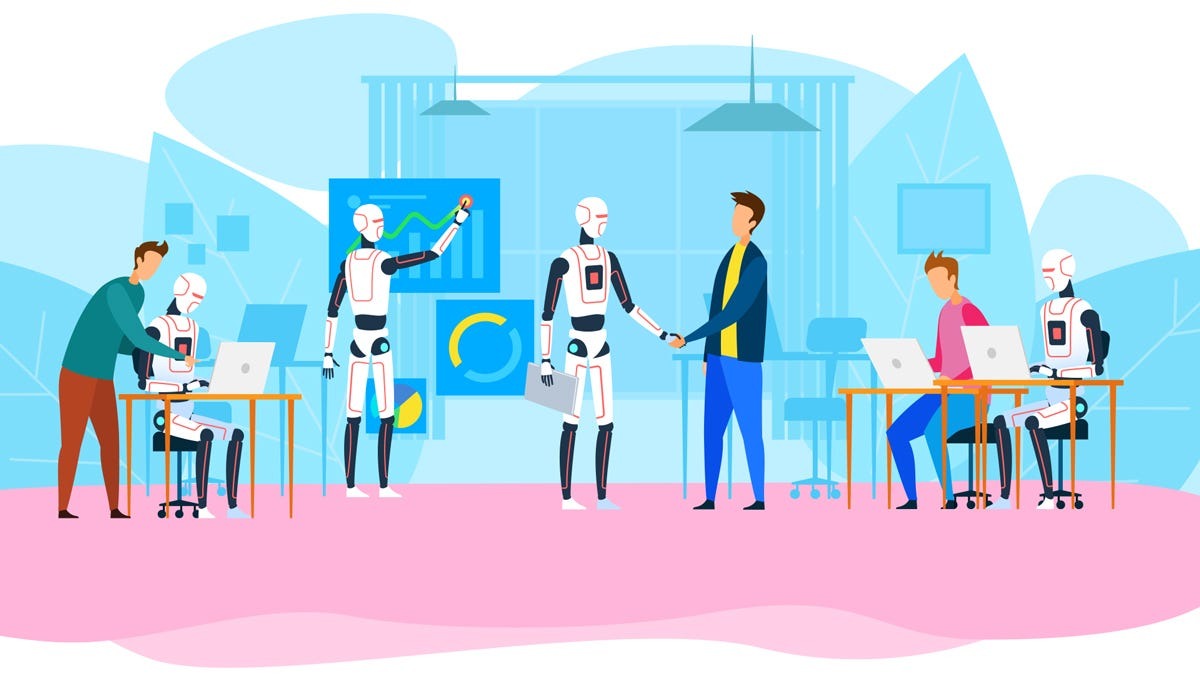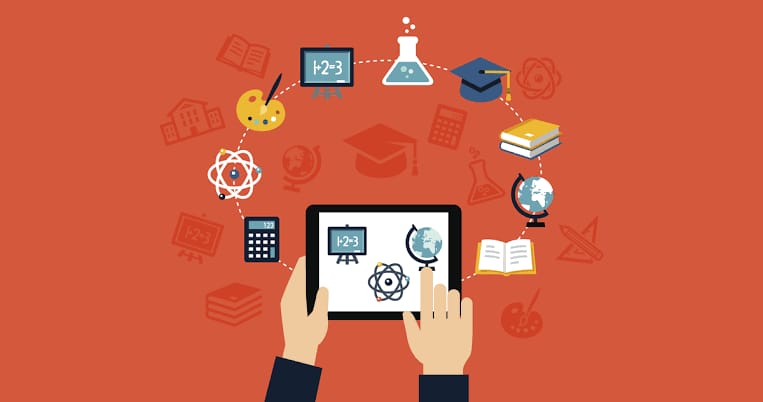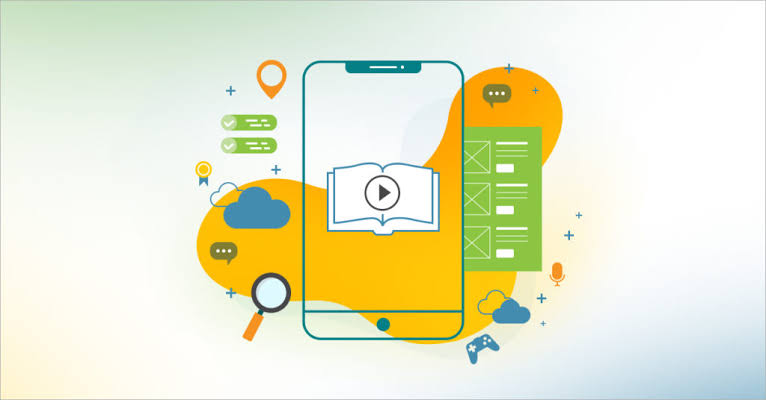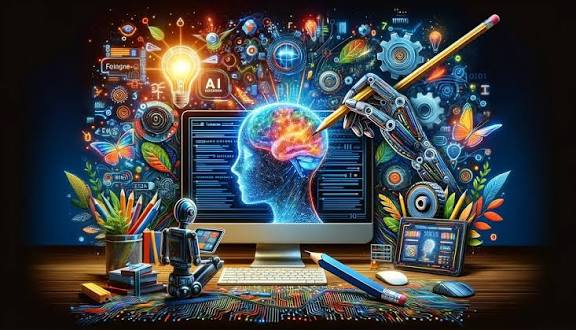
The Future of Work: AI Coworkers and Human Creativity.
Artificial Intelligence is no longer just a tool but an emerging coworker, transforming how industries function and redefining human creativity. As machines handle repetitive and data-heavy tasks, humans can focus on empathy, vision, and innovation. The future of work lies not in rivalry but in collaboration, where AI amplifies human potential.
✨ Raghav Jain

The Future of Work: AI Coworkers and Human Creativity
The 21st century workplace is undergoing one of the most profound transformations in human history. The advent of artificial intelligence (AI) has not only reshaped industries but also redefined what it means to be productive, creative, and collaborative. For decades, machines have replaced humans in repetitive and labor-intensive tasks, but AI introduces something new: cognitive automation. Unlike traditional machines, AI systems can think, learn, and adapt—qualities once thought to be uniquely human.
This evolution raises questions that are both exciting and unsettling: What does the future of work look like when AI systems become our coworkers? How will human creativity evolve when machines are capable of generating ideas, content, and even solutions? And, perhaps most importantly, how can humans and AI collaborate effectively to drive innovation rather than compete destructively?
In this article, we’ll explore the future of work with AI coworkers, examining opportunities, challenges, and the vital role of human creativity in ensuring that AI remains a tool for progress rather than displacement.
1. The Rise of AI Coworkers
AI coworkers are not science fiction anymore—they are already among us. From chatbots in customer service to AI-powered code assistants for software developers, these systems are functioning side by side with humans. Unlike robots of the industrial era, today’s AI tools are not just machines performing physical labor but digital collaborators assisting with intellectual tasks.
For example:
- Healthcare: AI can analyze medical images, predict patient outcomes, and provide diagnostic suggestions, allowing doctors to focus on empathy-driven care and complex decision-making.
- Marketing: AI generates insights from consumer behavior, writes targeted ad copy, and predicts trends, giving marketers more room for strategy and creativity.
- Education: AI tutors offer personalized learning, freeing teachers to engage in deeper, human-centered interactions with students.
These examples illustrate how AI doesn’t necessarily replace jobs outright but rather changes the scope of human work. The keyword here is augmentation. AI coworkers extend human capabilities, often taking over mundane or data-heavy aspects of jobs, which allows humans to focus on areas requiring critical thinking, empathy, and originality.
2. Redefining Human Creativity
One of the most striking consequences of AI’s rise in the workplace is the redefinition of creativity. Traditionally, creativity was considered a human monopoly—an outcome of emotion, intuition, and abstract thought. However, AI-generated art, music, and writing challenge this assumption. Programs like DALL·E, ChatGPT, and others show that machines can create outputs that feel remarkably “creative.”
But does this mean humans are being replaced in the realm of creativity? Not exactly. Instead, AI creativity is more of a mirror and amplifier of human imagination. These systems generate outputs based on vast datasets, which means they don’t originate ideas in the human sense but remix and extend what has already been created.
For instance:
- A designer may use AI to generate dozens of logo variations, then use their artistic judgment to refine the best one.
- A novelist may use AI for brainstorming plotlines but infuse the story with human emotion, cultural context, and nuance.
- A researcher may rely on AI to analyze thousands of scientific papers, identifying patterns and gaps that lead to new hypotheses.
Thus, AI shifts human creativity from the act of production to the act of curation, judgment, and vision. The future of creativity lies in synergy: humans bring imagination, values, and empathy, while AI contributes scale, speed, and precision.
3. Opportunities in AI-Human Collaboration
The integration of AI coworkers into the workplace unlocks unprecedented opportunities across industries.
a) Increased Efficiency and Productivity
AI can perform repetitive and time-consuming tasks in a fraction of the time it takes humans. For example, in the legal field, AI tools can review contracts or legal documents rapidly, identifying risks and relevant clauses. Lawyers, then, can spend more time building arguments, negotiating deals, and advising clients.
b) Enhanced Decision-Making
AI’s ability to process vast datasets means that it can uncover insights that humans might miss. In finance, AI algorithms can predict market movements by analyzing global data streams, helping investors make better decisions. Yet, human intuition and experience remain crucial, especially in volatile or unprecedented situations.
c) Democratization of Creativity
AI tools make creativity more accessible to individuals who may not have traditional skills. A non-musician can create complex music tracks using AI software. Entrepreneurs without design backgrounds can build sleek websites with AI-powered design assistants. This democratization encourages innovation from diverse voices.
d) New Job Creation
While some jobs may disappear, new categories are emerging. For example, “prompt engineers,” “AI ethicists,” and “human-AI interaction designers” are jobs that didn’t exist a decade ago. This mirrors historical shifts: when automation transformed agriculture, it created opportunities in manufacturing and services.
4. Challenges and Risks
While opportunities abound, the rise of AI coworkers also poses significant challenges.
a) Job Displacement
One of the most pressing concerns is the displacement of workers in industries heavily dependent on routine tasks. Roles such as data entry clerks, paralegals, or customer service representatives face the risk of automation. Without reskilling initiatives, entire communities could face economic dislocation.
b) Ethical Concerns
AI systems may reflect biases embedded in their training data. For instance, hiring algorithms have been criticized for discriminating against certain demographic groups. The ethical use of AI in the workplace will require constant vigilance, transparency, and regulation.
c) Creativity Dilution
There is a concern that reliance on AI for creative tasks might dilute originality. If too many creators depend on AI-generated outputs, there is a risk of homogenization in art, literature, and innovation. True creativity thrives on diversity of thought, which machines cannot fully replicate.
d) Human Dependency and Skill Loss
If humans over-rely on AI tools, they may lose essential skills. For example, if professionals depend entirely on AI to generate presentations, their own ability to communicate complex ideas could atrophy. Balancing assistance with active skill development will be critical.
5. The Future Landscape of Work
The workplace of the future is unlikely to be one where AI replaces humans entirely. Instead, it will be one where humans and AI coexist and co-create. Several trends are already emerging:
- Hybrid Teams: Humans and AI systems will increasingly collaborate as integrated teams. Just as project teams today include people with diverse skills, future teams may include AI agents as recognized contributors.
- Focus on Human Skills: Soft skills such as empathy, leadership, ethics, and storytelling will grow in importance. These are areas where machines struggle to compete with humans.
- Continuous Reskilling: Lifelong learning will become the norm. As AI reshapes industries, workers will need to constantly update their skills to remain relevant.
- Ethical AI Frameworks: Companies will develop stronger governance around AI, ensuring its use aligns with societal values and organizational missions.
Ultimately, the future of work is not a story of competition between humans and machines—it is a story of collaboration, where AI amplifies human potential rather than diminishes it.
The 21st century workplace is undergoing one of the most profound transformations in human history, and at the center of this shift stands artificial intelligence (AI), not merely as a tool of automation but as a coworker capable of assisting in cognitive and creative tasks once thought to be uniquely human. For decades, machines replaced human labor in factories and industries where repetitive, physical work dominated, but the emergence of AI has introduced something fundamentally different: intelligent systems that can learn, analyze, and generate ideas in ways that mimic aspects of human thought. This evolution forces us to ask what the future of work looks like when AI becomes part of the team, how human creativity adapts in this new environment, and whether machines will compete with us or ultimately serve as collaborators. AI is already reshaping industries—healthcare professionals work alongside AI diagnostic tools that scan images and predict illnesses faster than humans; marketers use AI to predict trends, analyze consumer behavior, and even draft persuasive ad copy; educators rely on AI tutors to personalize learning experiences, freeing them to engage more meaningfully with students; and in creative industries, artists, writers, and musicians increasingly use AI to brainstorm, draft, and experiment. This growing presence of AI in professional life does not eliminate the need for human effort but rather shifts the boundaries of what we contribute, creating a model of augmentation rather than replacement. Human creativity, which has long been considered the pinnacle of cognitive achievement, is now being challenged and redefined in light of AI systems capable of generating text, music, art, and designs that seem impressively inventive. However, AI’s creativity is fundamentally different: it is not about original inspiration but about drawing from massive datasets, remixing and recombining patterns, and producing outputs that humans can then evaluate, refine, and contextualize. A novelist might use AI to brainstorm multiple plotlines yet still rely on human emotional depth to bring characters to life; a designer may generate dozens of AI-driven logos before selecting and perfecting one that embodies cultural meaning; and a researcher might depend on AI to process thousands of academic articles, yet the leap of intuition to form a groundbreaking hypothesis remains distinctly human. In this sense, AI is less a rival and more an amplifier of imagination, freeing humans to focus on the aspects of creation that machines cannot replicate: empathy, vision, storytelling, and ethical reflection. The opportunities from human-AI collaboration are immense—AI can handle repetitive or data-heavy tasks with unmatched efficiency, thereby boosting productivity and giving professionals more time for strategy, critical thinking, and interpersonal engagement. Decision-making is enhanced through AI’s ability to identify hidden patterns in vast datasets, providing valuable insights in finance, healthcare, and logistics. Creativity becomes more democratized as AI lowers barriers: individuals without formal training in music, design, or coding can now experiment and produce meaningful works with AI assistance, opening the doors to innovation from diverse voices and backgrounds. New types of jobs are emerging as well, such as AI ethicists, prompt engineers, and human-AI interaction specialists, much as industrial revolutions of the past created new professions after displacing older ones. Yet, this transformation is not without challenges. Job displacement is a real and immediate concern for sectors where routine, predictable tasks dominate, such as clerical work, data entry, and basic customer service; without proactive reskilling programs, workers may find themselves excluded from the new economy. Ethical dilemmas also arise: AI systems often reflect biases in their training data, leading to unfair or discriminatory outcomes in hiring, policing, or lending, making transparency and regulation critical. Overreliance on AI poses risks of skill erosion, as humans might gradually lose abilities they no longer practice if machines consistently handle them. Furthermore, some critics worry about the dilution of originality if too many creators rely on machine outputs, potentially leading to homogenization of art, literature, and cultural expression. These risks underscore the importance of balance: using AI as a partner rather than a crutch. Looking forward, the workplace will not become a battleground where humans are replaced wholesale by machines; instead, it will evolve into a hybrid environment where AI agents are seen as teammates. Just as diverse skills among human team members drive innovation, future teams may integrate AI systems as recognized contributors, performing roles humans cannot match in speed or scale while humans provide vision, empathy, and moral compass. Soft skills such as leadership, storytelling, and ethics will only grow in value, as they represent the dimensions of human intelligence that machines cannot mimic. Lifelong learning will become the norm, as workers will need to continuously adapt and reskill in response to technological change. Organizations will increasingly implement ethical AI frameworks to ensure transparency, fairness, and alignment with societal values. In conclusion, the rise of AI coworkers heralds a future of work that is both challenging and full of opportunity. While AI can generate creative outputs, optimize processes, and democratize innovation, human creativity remains irreplaceable because it carries emotional resonance, cultural nuance, and ethical responsibility. The most successful future will be one in which humans and AI collaborate—where machines extend our capabilities while we safeguard originality, empathy, and vision. The story of tomorrow’s workplace is not about rivalry but about partnership, and the individuals and organizations that thrive will be those who embrace AI as a powerful ally while cultivating uniquely human strengths.
The future of work is unfolding before our eyes as artificial intelligence (AI) reshapes industries, workplaces, and the very meaning of creativity, no longer confined to science fiction but present in everyday collaboration between humans and intelligent systems that act less like tools and more like coworkers. For decades, machines have replaced humans in tasks of physical labor, but AI represents a radical leap because it performs cognitive functions—analyzing data, generating ideas, and even producing artistic content—that blur the boundaries of human uniqueness. In healthcare, AI assists doctors by detecting diseases in scans with speed and accuracy, allowing physicians to dedicate more time to empathy-driven care; in marketing, algorithms draft ad copy, predict trends, and analyze consumer behavior, freeing strategists for big-picture thinking; in education, AI tutors personalize learning paths, enabling teachers to focus on mentorship; and in the arts, programs like DALL·E or ChatGPT generate images, text, and music that appear startlingly creative, though they are ultimately based on patterns in massive datasets. This shift has redefined creativity itself: while humans once saw imagination as uniquely ours, AI now demonstrates an ability to remix knowledge and generate outputs that humans can judge, refine, and contextualize, meaning our role shifts from producer to curator, visionary, and ethical guide. A novelist may brainstorm plot twists with AI yet must add emotional depth and cultural resonance; a designer may generate countless logos with AI yet still provide the aesthetic judgment that connects with human audiences; a researcher may rely on AI to parse thousands of scientific papers but still needs intuition to form groundbreaking hypotheses. The opportunities are immense: AI boosts productivity by taking over repetitive tasks, enhances decision-making by identifying patterns invisible to humans, democratizes creativity by empowering non-experts to design, compose, or code, and creates entirely new job categories like AI ethicists, prompt engineers, and human-AI interaction designers. Yet challenges abound: job displacement threatens roles reliant on routine tasks, such as clerical work and data entry, unless reskilling efforts keep pace; ethical risks loom when AI systems reflect biases embedded in their training data, potentially leading to discrimination in hiring or lending; over-reliance on AI risks eroding human skills if workers stop practicing what machines perform; and cultural originality may decline if too many people rely on similar algorithmic outputs, producing homogenization in art, literature, and design. The balance lies in collaboration rather than competition, envisioning future workplaces where humans and AI function as hybrid teams, each contributing complementary strengths: AI offers speed, precision, and data-driven insights, while humans provide imagination, empathy, ethics, and leadership. In such a world, soft skills like storytelling, emotional intelligence, and moral reasoning will become even more valuable because they are qualities AI cannot replicate. Continuous learning will be essential, as workers adapt to evolving technologies and industries, while organizations will increasingly adopt ethical frameworks to ensure transparency, accountability, and fairness in AI deployment. The conclusion is clear: AI is not here to replace us but to amplify us, pushing humans to elevate their creative and ethical capacities. The future of work belongs not to machines or to humans alone but to partnerships where machines extend human potential while humans safeguard values and originality, ensuring progress serves people rather than displaces them. To summarize, the arrival of AI coworkers offers both extraordinary promise and genuine risks, but the key lies in using them as partners that enhance human creativity instead of rivals that replace it. Human imagination, cultural depth, and emotional connection remain irreplaceable, and by embracing lifelong learning and ethical use of technology, society can ensure that AI drives progress rather than inequality. Q&A further clarifies these issues: when asked whether AI will completely replace humans, the answer is no, because while repetitive tasks may be automated, creativity, empathy, and leadership remain essential; when asked how workers can prepare, the answer is continuous reskilling in critical thinking, digital literacy, and emotional intelligence; when asked if AI is truly creative, the answer is that its creativity is derivative, remixing existing data rather than producing genuine originality; when asked which industries benefit most, healthcare, finance, education, and creative fields stand out due to AI’s ability to handle data-intensive tasks and personalization; and when asked about ethical concerns, the answer highlights fairness, transparency, accountability, and avoiding bias. Ultimately, the lesson is that the most successful individuals and organizations of tomorrow will be those who learn to collaborate with AI, harnessing its power as an ally while strengthening the uniquely human qualities that no machine can replicate.
Conclusion
The future of work with AI coworkers is both promising and challenging. AI is poised to transform industries by enhancing efficiency, democratizing creativity, and enabling better decision-making. However, it also brings risks of job displacement, ethical dilemmas, and skill dependency.
Human creativity remains indispensable in this new era. While AI can generate ideas and perform tasks with remarkable efficiency, it lacks the emotional intelligence, cultural awareness, and visionary thinking that humans provide. By embracing a collaborative mindset, we can ensure that AI serves as a tool for progress rather than a threat.
The key takeaway: The future belongs to those who can leverage AI as a partner while nurturing and protecting uniquely human creativity.
Q&A Section
Q1: Will AI replace human workers completely in the future?
Ans: No, AI is more likely to transform jobs rather than eliminate them completely. While routine and repetitive tasks may be automated, human creativity, empathy, and decision-making will remain essential.
Q2: How can workers prepare for a future with AI coworkers?
Ans: Workers should focus on continuous reskilling, particularly in areas like critical thinking, emotional intelligence, and digital literacy. Embracing lifelong learning will be key to staying relevant.
Q3: Can AI be considered truly creative?
Ans: AI can generate creative outputs, but its creativity is derivative—it draws from patterns in existing data. True originality, emotional depth, and cultural context still belong to human creativity.
Q4: What industries will benefit the most from AI coworkers?
Ans: Healthcare, education, finance, and creative industries will see significant benefits. AI can handle large-scale data analysis, personalization, and repetitive tasks, enabling humans to focus on strategic and creative aspects.
Q5: What ethical issues must be considered when using AI at work?
Ans: Bias, transparency, accountability, and fairness are key issues. AI systems must be carefully monitored to avoid discrimination, misuse of data, and over-reliance that harms human decision-making.
Similar Articles
Find more relatable content in similar Articles

Top Educational Apps That Boos..
Educational apps are transfor.. Read More

From Classroom to Career: App..
Skill-building apps help stud.. Read More

The Future of Social Media Ma..
AI is transforming social med.. Read More

Smart Study to Smart Career: ..
Smart study and career apps a.. Read More
Explore Other Categories
Explore many different categories of articles ranging from Gadgets to Security
Smart Devices, Gear & Innovations
Discover in-depth reviews, hands-on experiences, and expert insights on the newest gadgets—from smartphones to smartwatches, headphones, wearables, and everything in between. Stay ahead with the latest in tech gear
Apps That Power Your World
Explore essential mobile and desktop applications across all platforms. From productivity boosters to creative tools, we cover updates, recommendations, and how-tos to make your digital life easier and more efficient.
Tomorrow's Technology, Today's Insights
Dive into the world of emerging technologies, AI breakthroughs, space tech, robotics, and innovations shaping the future. Stay informed on what's next in the evolution of science and technology.
Protecting You in a Digital Age
Learn how to secure your data, protect your privacy, and understand the latest in online threats. We break down complex cybersecurity topics into practical advice for everyday users and professionals alike.
© 2025 Copyrights by rTechnology. All Rights Reserved.